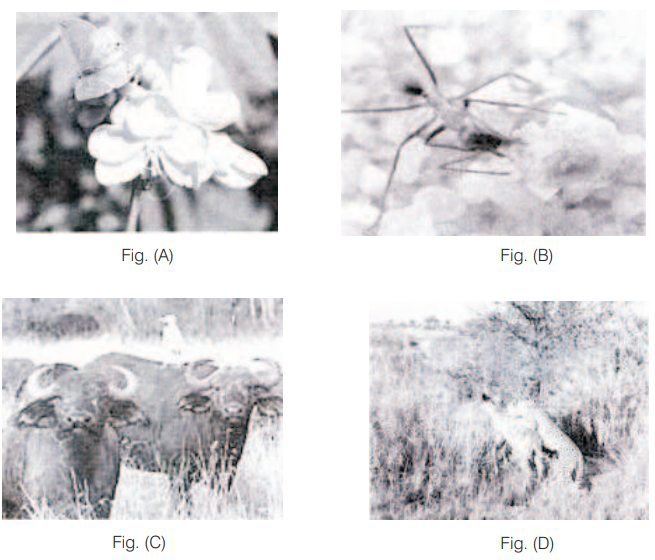List any four characters that are employed in human population census.
A population has the following characterstics that are employed in human population census.
(i) Natality and mortality
(ii) Sex ratio
(iii) Population density
(iv) Age distribution
(v) Population growth
Give one example for each of the following types
(a) Migratory animal
(b) Camouflaged animal
(c) Predator animal
(d) Biological control agent
(e) Phytophagous animal
(f) Chemical defense agent
(a) Migratory animal-American buffalo and dolphin.
(b) Camouflaged animal-Grasshopper and chameleon.
(c) Predatoranimal-Lion.
(d) Biological control agent-Myxoma virus to kill European rabbit and Gambusia fish to check growth of mosquito larvae.
(e) Phytophagous animal-Insects (beetle, butterfly, etc.).
(f) Chemical defense agent-Cardiac glycosides.
$$ \text { Fill in the blanks } $$
| Species A | Species B | Type of Interaction | Example |
|---|---|---|---|
| + | - | __ | __ |
| + | + | __ | __ |
| + | __ | Commensalism | __ |
| Species A | Species B | Type of Interaction | Example |
|---|---|---|---|
| + | - | Predation | Phytophagous animal and plants. |
| + | + | Protocoperation | Oxpecker and black rhino |
| + | - | Comensalism | Sea anemone and Hermit crab |
Observe the set of 4 figures $\mathrm{A}, \mathrm{B}, \mathrm{C}$ and D and answer the following questions.
I. Which one of the figures shows mutualism?
II. What kind of association is shown in D?
III. Name the organisms and the association in C.
IV. What role is the insect performing in $B$ ?

I. Figure A show a pollinator (bee) on a flower. The association between pollinator insect and plant is termed as mutulalism.
II. Predation.
III. Egrets and grazing cattle is good example of commensalism.
IV. Scavenging- The insect is playing the role of an scavenger.
Comment on the following figure: I, II and III, A, B, C, D, G, P, Q, R, S are species.

Figure I It is a single population and all individuals are of the same species, i.e., a individuals interact among themselves and their environment intraspecific interaction.
Figure II It is a community and it contains three populations of species A, B and C. They interact with each other and their environment and is called interspecific interaction.
Figure III It is a biome. It contains three communities of which one is in climax and other two are in different stages of development. All three communities are in the same environment and they interact with each other and their environment.